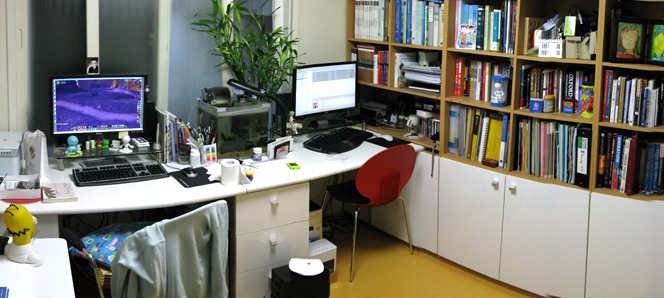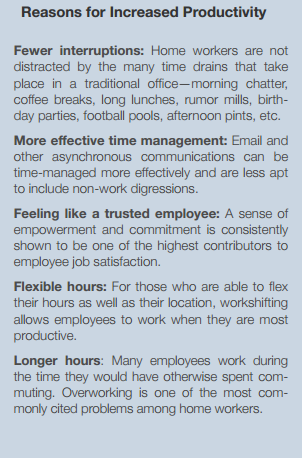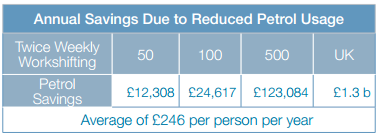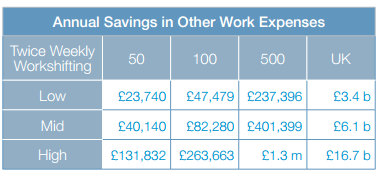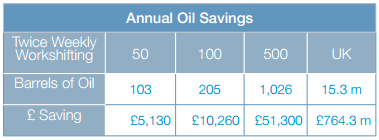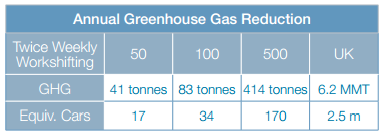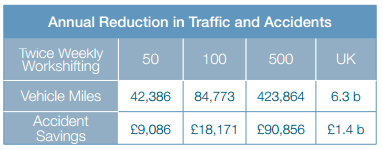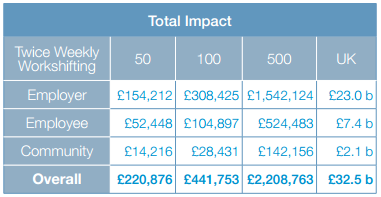Introduction
 Thanks to advances in technology, work no longer needs to be tethered by time or place. Citrix Online describes this shift from ‘work’ as a noun to ‘work’ as a verb, as ‘workshifting’. The purpose of this paper is to quantify the financial and environmental benefits of this growing trend. It will show how twice weekly home working, by those with compatible jobs and a desire to do so, could save UK companies, employees, and the community over £4,300 per year per participant. At the national level, the savings would total over £32 billion a year.
Thanks to advances in technology, work no longer needs to be tethered by time or place. Citrix Online describes this shift from ‘work’ as a noun to ‘work’ as a verb, as ‘workshifting’. The purpose of this paper is to quantify the financial and environmental benefits of this growing trend. It will show how twice weekly home working, by those with compatible jobs and a desire to do so, could save UK companies, employees, and the community over £4,300 per year per participant. At the national level, the savings would total over £32 billion a year.
Workshifting—also known as telework, telecommuting, or ework—covers a broad range of work arrangements including mobile work, remote work at a client’s location, work at a shared office centre or hub, and home work. In most countries, government numbers on the home-based workforce also includes the self-employed. Whilst all forms of workshifting have their benefits, the focus of this paper is on employee home working. There are two reasons for this. First, it’s been more extensively studied and better documented than other forms of workshifting. Second, by replacing the daily commute, home-based workshifting offers the greatest qualitative and quantitative benefits for all constituents.
By any name, the concept has been slower to catch on than its advocates have hoped. Whilst worries over weather calamities, the spread of disease, terrorism, rising fuel prices, and road closures often spike temporary interest in workshifting, less transient issues are now driving its widespread adoption.
Much has happened since telework was first proposed as a solution to traffic congestion in the 1970s. Certainly the ‘how’ of remote work has changed. Technologies we didn’t dream about three decades ago are now ubiquitous. But the ‘why’ of it has changed too. Just three years ago saving money was rarely mentioned as an impetus for workshifting initiatives. Labour shortages, better work-life balanc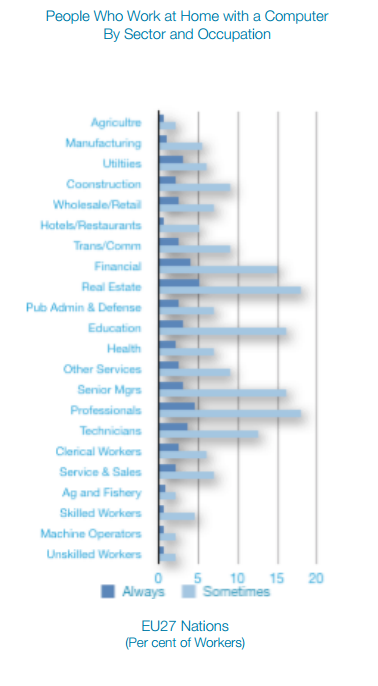 e, environmental sustainability, and continuity of operations were the principal drivers. As we recover from the recession, those issues will reignite the flame, but workshifting’s potential to dramatically reduce costs and increase productivity will sustain the burn.
e, environmental sustainability, and continuity of operations were the principal drivers. As we recover from the recession, those issues will reignite the flame, but workshifting’s potential to dramatically reduce costs and increase productivity will sustain the burn.
Thousands of companies and millions of employees in a wide range of industries across the globe already workshift successfully. They’re proof that the traditional barriers such as management mistrust, security, cost, employee isolation, worries about career advancement, and difficulties collaborating can be overcome with a combination of technology and cultural change. And they’ve proven that the bottom-line benefits are worth the effort.
’Businesses are embracing technology and utilising homebased teams of employees and entrepreneurs working together to deliver results’, says Emma Jones, author and founder of Enterprise Nation. ’It’s an arrangement where everyone wins; the individual benefits from the freedom and flexibility that comes with working from home and the company receives access to the best people, higher productivity, and better accountability.’
Communities are reaping the benefits of workshifting too. It can significantly reduce traffic congestion (a 2.5% reduction in traffic can cut time lost in traffic by 25%1) and reduce the need for new road construction. It can provide fuller employment for unemployed and underemployed persons. It can slow the brain drain of the retiring boomer generation and reduce the offshoring of jobs. It can deter the outbound migration of talent from rural communities. It can reduce energy usage and oil imports. And it can mitigate the impact of small and large disasters on national productivity.
But, the UK has fallen behind other nations in its adoption of this new way to work. Among the EU27 (and Norway), the UK ranked 12th in the percentage of those with employees working at home a quarter or more of the time.
A special analysis of home-working data from the Labour Force Survey conducted for the Workhubs—Smart Workspace for the Low Carbon Economy report (2010) revealed that employees who consider home their primary place of work account for only 4.9 per cent of the labour force—a figure that has grown little over the past decade and is a long way from what’s possible.
Over the past thirty years knowledge intensive industries have driven job creation and productivity gains in the UK. Between 1995 and 2005, for every one job created in ‘other’ services, 12 new jobs were created in knowledge intensive services. Recent studies suggest that as many as two-thirds of UK jobs are now workshifting-compatible4 and a similar level of employees say they’d work from home at least some of the time if allowed—more than a third would forego a pay raise to do so.
In the face of a record high deficit, billions in planned spending cuts, high unemployment and significant underemployment, low productivity, looming environmental mandates, the threat of rising oil prices, and the changing needs and wants of the population, ‘business as usual’ simply isn’t sustainable for either government or business.
A 2007 Equal Opportunities Commission investigation into the Transformation of Work offers this picture of the future:
’The potential for many types of work functions to be carried out in location-independent ways has added a new, growing, but still vastly unexploited dimension to the way work is organised. Requiring employees to always make the trip into the office to perform work tasks is fast becoming a sign of dinosaur organisations and a turnoff for new job seekers, particularly a new generation who have grown up with technology and are aware of the freedom it can bring. Evidence suggests that this will hit the jackpot—the ability to work at home is high on the list of work-wants from young and older people alike and case studies show that giving greater control and empowerment to individuals in bluecollar as well as white collar jobs can deliver higher levels of productivity than their office-bound colleagues.’
The remainder of this paper is organised into three sections that summarise the savings and benefits of home workshifting for employers, employees, and communities. The total value of benefits is provided for 50, 100, and 500 participants, and for the UK as a whole. The quantified benefits include:
‣ Employer Benefits
Higher productivity
Lower real estate and related costs
Reduced absenteeism and turnover
‣ Employee Benefits:
Lower petrol and auto expenses
Reduced work-related expenses
Increased free time
‣ Community Savings: Lower oil imports
Reduced greenhouse gases
Fewer traffic accidents
Reduced vehicle miles
Whilst there are many other benefits to be derived from workshifting, not all are easily reduced to numbers. Those are listed at the end of each section.
Telework Savings Calculator
The financial benefits presented in this paper were derived from the Telework Research Network’s proprietary Telework Savings Calculator. The assumptions behind the model are based on an analysis of over 400 UK, U.S., and global case studies, research papers, books, and other sources. Additional information was gathered from dozens of interviews with top virtual employers, advocates and naysayers, researchers, and leaders of successful workshifting programmes in both the public and private sector.
The primary sources of data used to develop the UK Telework Savings Calculator include:
‣ British Chambers of Commerce
‣ Chartered Institute of Personnel and Development
‣ Confederation of Business Industry,
‣ Cushman & Wakefield UK Market Beat
‣ Equality and Human Rights Commission
‣ Eurofound ‣ European Union: European Social Fund
‣ Forrester Research Inc
‣ HM Revenue & Customs
‣ McKinsey Global Institute
‣ Orange Future Enterprise Coalition
‣ Reason Foundation
‣ Royal Automobile Club Foundation
‣ Trade Union Congress
‣ Transport for London
‣ UK Department for Transportation
‣ UK Office of National Statistics
‣ UK Labour Force Survey
‣ UK Department of Energy and Climate Change
‣ UK Automobile Association
Telework Savings Calculator: General Assumptions
The following assumptions provide the basis for the analysis that follows:
- Home working average of 2 days per week (based on a 2008 Chartered Institute of Personnel and Development study)
- Total Population Model
- Assumes 50 per cent of workforce could work from home at least part of the time (based on three independent assessments) 8
- Excludes those who already do so regularly and the self-employed (based on 2008 Labour Force Survey data)
- 67 per cent of that population would do so if given the opportunity (based on multiple sources including 2009 Orange/YouGov survey of over 3,000 UK employees) 9
- Company model:
- Assumes 50, 100, and 500 workshifters
- Notations throughout: b = billion, m = million
Employer Benefits
Twice weekly home working could save employers over £3,000 per person each year. The primary financial benefits for employers come from increased productivity, reduced real estate costs, and lower absenteeism and turnover.
Productivity Impact
Whilst lack of management buy-in and concerns that people won’t work as hard if left on their own is the most commonly cited obstacle to the adoption of workshifting programmes, the fact is that study after study show people who work from home are more productive than their office counterparts.
‘One of the biggest holdbacks in home working is that managers worry that the distraction of domestic activities and motivational issues will reduce employee effectiveness,’ said Peter Thomson, Research Director for the UK Telework Association. ‘However there is no data to prove this prejudice and plenty to counter it.’
Industry Research on Productivity
British Telecom’s home-based call centre agents answer 20 per cent more calls than their office counterparts.BT’s Anytime Anywhere working scheme shows a 15 per cent to 31 per cent increase in productivity across various functions.
A 2007 report by Orange Future Enterprise (summarising over 1,400 interviews, workshops, and forums) showed that three quarters of those who worked flexibly—either in terms of place or time—report being able to concentrate better.
In a study of more than 24,000 global workers, 80 per cent of IBM managers agreed that productivity increases in a flexible environment.
In 2006, the Industrial Relations Service (IRS) surveyed 66 employers about their policies on and experience with flexible working and telework. When asked about the impact of telework on employee productivity, 38 per cent of respondents felt very positive, 40 per cent positive, and 22 per cent were neutral. None reported a negative impact.
U.S. architecture practice, Gensler—the firm behind the new interior of the London Stock Exchange, recently asked 200 senior and middle managers about their work environment. Almost half said they found it hard to be creative or innovative in the office, and 36 per cent said they were more productive when working at home.
A study of the return on investment from telework prepared Booz Allen for the U.S. General Services Administration reported an increase in productivity of 1 hour per day among teleworkers.
Best Buy measured an average productivity increase of 35 per cent through its flexible work programme.
Telework Savings Calculator: Productivity Assumptions
- 20 per cent increase in productivity on home working days (based on a wide range of actual company experiences including those listed above)
- Whilst the majority of home workers are more senior level people, the per person income assumption is based on the much lower national
Real Estate and Electricity Impact
Traditional offices are expensive, inefficient, inflexible, and difficult to scale—particularly down. Home working programmes can reduce the capital drain of owning or leasing a building. Though not quantified in the model, a home working programme can also save on parking lot leases, furniture, supplies, maintenance, security, janitorial, insurance, taxes, common area, and other related costs. It can also dramatically reduce a company’s carbon footprint—something that’s becoming increasingly important in both the public and private sector.
Based on data from the largest validated database of office property in the UK, a 2007 government report found that government office occupancy is about 25 per cent less efficient than in the private sector. Through improved space efficiency, workshifting and office hoteling, it suggests the average per person space could be reduced to 12 m2. With more than a sixth of government offices now occupying more than 24 m2 per person, the report estimates the savings across government properties could total £1.25 billion a year.
The 2007 report demonstrates that organisations can achieve significant savings in both real estate and energy use through a combination of more efficient use of space, better use of technology, and new ways of working:
‘The opportunity to reduce facility costs, by reconfiguring office space or reducing the average space allocated to each worker is an opportunity corporate leaders cannot ignore’, said Jim Creighton, co-founder of New Ways of Working, a member organisation focused on alternative workplace solutions. He points to realworld examples where companies have saved millions of square feet of real estate and reduced occupancy costs by optimising their footprint, employing workplace flexibility, and implementing processes and places that support mobile work.‘It is clear that growing numbers of organisations are dramatically changing the way in which they occupy their office buildings. Part of the drive is economic as organisations respond to cost pressure.
But part of the drive is organisational as they transform their work processes to respond to new operational pressures. Static production line-style offices are giving way to more dynamic work environments in which team work, collaboration and meeting space occupy far greater proportions of space. It is well known that traditional office layouts are, typically, half empty for most of the time due to people working out of the office, and many organisations have introduced hot-desking, desk sharing and alternative work styles to improve utilisation. Such initiatives allow a building to support more people in the same amount of space. Their impact on overall densities can be dramatic, often reducing an organisation’s appetite for space by around 20 per cent to 30 per cent.’
Hewlett Packard, for example, has for years acquired people through organic growth and through mergers and acquisitions yet, at the same time, they’ve shrunk their real estate footprint. ‘We’re currently about 75 per cent complete in a space reduction exercise called the Global Workplace Initiative to reduce office space by 50 per cent and reduce occupancy costs by approximately 40 per cent’, said Chris Hood, Programme Manager for that initiative. Through a combination of mobile work initiatives and space reconfiguration, HP has been able to drive utilisation from 30 per cent to 40 per cent levels—not atypical in modern offices—towards a target of 80 per cent in just 3 years. He noted that the ratio of employees to desks varies by job, location—both by city and country, and other factors. In some places they have desk sharing ratios of 2:1. In others, they’ve been successful with ratios as high as 20 to 1.
‘Good data is absolutely critical’, says Mark Wartenberg, Founding Partner at Co3 Group Ltd. ‘It shows the difference between what people think their real estate utilisation is and what it actually is.’ At Sun Microsystems, Wartenberg’s former employer, they’d been measuring utilisation since 2001. As a result, they could prove that in some areas utilisation was only 20 per cent. By the end of 2008, utilisation was approaching 75 to 80 per cent. The improvement was achieved by supporting people’s choices for where they work, supportive management policies, and enabling network technologies.
Industry Research on Real Estate Savings
Sun Microsystems saves £43 million a year in real estate costs, £1.9 million a year from reduced power consumption, and £16 million a year in IT expenditures with flexible work options for its 17,000 employees (2,000 primarily working at home, 15,000 up to 2 days a week). At Oracle BV, redesigned workspaces, hot-desking, and electronic access to documents improved interaction between staff and reduced space from 23 m2 per employee to 13 m2.
Telework Savings Calculator: Real Estate Assumptions
- Average office cost = £4,292/year (based on a 2007 government report) though it should be noted that London offices can run 2-3 times higher.
- Reduction with 2 day a week home working = 15 per cent (based on a 2007 government report)
- Electricity savings = 4,400 kWh per person, per year (based on studies by Global Environment Technology Foundation and Sun Microsystems)
- Extra home office energy is shown as a cost in the Employee Savings section.
Absenteeism Impact
Unscheduled absences cost employers billions. They necessitate staffing redundancies, they inconvenience coworkers and customers, they reduce productivity, they increase insurance costs, they impact service quality, and they demoralise staff. According to the CCH 17th Unscheduled Absence Survey—the definitive survey of absenteeism in the workplace in America— 66 per cent of those who call in sick aren’t. They do so because of family issues (22 per cent), personal needs (18 per cent), entitlement mentality (13 per cent), and stress (13 per cent). Telework has proven to be the second most effective method of reducing absences (alternative work arrangements is first).
Home workers often continue to work when they’re sick. They’re able to return to work more quickly following pregnancy or surgery. And they’re able to handle personal appointments (e.g., appliance delivery, home repair, teacher consult, etc.) without losing a full day of work.
Home-based workers are sick or absent less often because they:
‣ Experience less stress;
‣ Are less exposed to sick co-workers;
‣ Are exposed to fewer occupational and environmental hazards;
‣ Avoid driving—the most dangerous part of their day;
‣ Have more time for exercise.
Perhaps the most important reason they’re absent less is that they are more satisfied with their job and therefore less likely to fabricate an illness.
The opposite of absenteeism, presenteeism is a chronic problem in organisations too—the mucus troopers who drag themselves to the office only to make everyone else sick aren’t doing anyone any favours. In a 2010 Government study of over 2,000 companies, 91 per cent of employees said they’d be quite likely or very likely to go to work with a cold.They do so because the company culture, benefits, or policies—perhaps unwittingly— encourage it. A 2008 study of mental capital and wellbeing by the Government Office for Science indicated that presenteeism is an even larger problem in terms of lost productivity than absences.
Industry Research on Absenteeism
BT’s Anytime Anywhere workers are absent 20 per cent less than the average UK employee.
Stress at work is associated with a 50 per cent excess risk of coronary heart disease. There is consistent evidence that high job demand, low control and effort-reward imbalance are risk factors for mental and physical health problems. Among the EU-27, the UK ranked 15th in terms of workplace autonomy, sixth highest in employees with monotonous tasks, 16th in feeling they often or almost always have enough time to get the job done, and 15th highest in per cent of employees working more than 48 hours a week.
Unscheduled absences cost employers and average of £692 per employee per year. Private / public sector absences average 6.4 / 9.6 per person, per year respectively. Absence rates vary by industry and size of employer with the largest employers, those with over 2,000 employees, showing the highest absence rate (10.2 days per year). Absenteeism costs UK employers over £20 billion a year.
Telework Savings Calculator: Absenteeism Assumptions
- Average reduction in absenteeism = 4.7 days a year (based on studies by BT, WorldatWork, and Booz Allen)
- Annual cost per unscheduled absence per person is £93.36 (based on CIPD 2009 data)
Attraction and Retention Impact
A 2010 study of over 7,500 European workers by Aon Consulting showed that nearly half of all UK workers planned to start job hunting by the end of the year. Only the Irish showed a higher intention to do so, with the rest of Europe showing much lower inclination.
A 2009 YouGov survey of over 2,000 UK workers showed that 67 per cent of the workforce would like to work from home at least part of the time. Another YouGov survey of 2,234 people in early 2006, found that 37 per cent of men and 34 per cent of women would give up part of their next pay rise if they could work from home.
Workshifting enhances attraction and retention because it:
‣ Is among the top non-financial benefits desired by employees;
‣ Expands the talent pool beyond geographic boundaries;
‣ Provides access to disabled workers;
‣ Offers alternatives that would have otherwise kept parents and senior caregivers out of the full-time workforce;
‣ Appeals to aging workers.
International research based on 8,000 companies in 32 countries shows that despite claims of a flexible labour market, Britain is lagging behind its competitors in flexible work arrangements.
The UK population is aging. By 2020 nearly a third of the workforce will be over 50. Boomers who haven’t already made their exit are anticipating it. At the same time, the number of young people of working age is falling. Meanwhile, the folks in the middle aren’t buying the old routine. Gen X watched their workaholic parents, and don’t want to make the same mistakes. Gen Y grew up independent, tech savvy, and were taught to question authority. Now they’re questioning their employers. This is not your father’s workforce. Businesses will have to fight for top talent in the decade ahead.
A 2010 Chartered Institute of Personnel and Development (CIPD) and Chartered Management Institute (CMI) study involving over a thousand members found that 54 per cent of older workers expect a better balance between their work and personal lives. Yet only 14 per cent of managers considered their organisation very well prepared to cope with the issues of an aging workforce.
Fifty-two per cent of women with children under 16 said they could not find full-time work that gave them the flexibility they needed.The estimated cost of under-utilising women’s skills is estimated to be between £15 and £23 billion a year—that’s 1.3 to 2.0 per cent of GDP.
According to a study by City and Guilds, 35 per cent of people not currently working could be encouraged back into work if more flexible working opportunities were available.
Whilst the government’s ‘Right to Request’ regulations may help promote workshifting, the Work Life Law Centre has compared the impact of similar regulations in the Netherlands, UK, and Germany and concluded that flexibility rights for all employees is a better approach. Their findings suggest that limiting the right to a subgroup not only causes resentment, but also makes it more difficult to accommodate requests.
A 2007 study by the Equal Opportunities Commission reiterates that in terms of flexible work, Britain is falling behind. ‘Flexibility is not happening fast enough, is not innovative enough and is sometimes introduced in a way that does not work well for either employees or employers. Meanwhile, the traditional model of work is being stretched to breaking point. Businesses are pushing workers to work long hours, leading to burnout and overall lower productivity per hour than workers on more limited hours in Europe. Regulation supporting flexibility is working well but is reinforcing a “concession culture” way of thinking about flexibility rather than positioning flexibility as available to everyone and able to deliver business benefits.’
Industry Research on Attraction and Retention
The Need for Work-Life Balance: In a study of more than 7,500 women in 17 different countries, the UK took 9th place in those who felt favorable about their work-life balance (55 per cent in the UK behind Mexico, Australia, Canada, U.S, Denmark, China, the Netherlands, and India).
A 2007 Department of Trade and Industry survey of 2,000 adults showed that:
‣ twelve per cent of women and 7 per cent of men had responsibility for adult care;
‣ those aged 45 to 54 had the highest level of caring responsibilities (15 per cent);
‣ twenty per cent of adult caregivers spent more than 20 hours a week doing so and another 14 per cent spent 11 to 20 hours a week.
According to a 2007 Equal Opportunities Commission report:
‣ being unable to find full-time flexible work was a problem for 43 per cent of adults working part-time, both men and women;
‣ nearly a third of parents with a dependent child said they had left a job or been unable to take one because of their parenting responsibilities;
‣ fifty-seven per cent of part-time employees and 61 per cent of people with children under five said they would have made different choices if better flexible working options were available to them.
A study covering 11,000 businesses conducted by Regus and reported by Flexibility.co.uk, indicated that 16 per cent of UK workers have considered leaving their job in the last two years because of the commute length. Among those with commutes of an hour or more (12 per cent of the UK workforce and 21 per cent of those who work in London), 39 per cent have considered it.
In staff surveys by HOP Associates, working at home 1 to 2 days a week ranked highest across all desired flexible benefits—chosen by 65 per cent of respondents. The longer the commute, the more likely workers were to choose home-based work. For all staff surveyed, the 3 most favoured options were working at home 1 to 2 days per week, more flexible hours each day, and compressed work weeks.
Evidence That Flexible Work Works:
In the 2009 CIPD Annual Recruitment, Retention and Turnover study, 65 per cent of companies indicated offering flexible work was their most effective hiring strategy. As a result of BT’s Anytime Anywhere working scheme 1,000 people who would have otherwise left were retained. Ninety-nine per cent of women there return to work after maternity leave compared to a UK average of 40 per cent. A survey of 1,440 employees conducted by the Orange Future Enterprise Coalition shows the lifestyle benefits of working flexibly are extremely important to employees.
Telework Savings Calculator: Attraction and Retention Assumptions
- Reduction in attrition = 7 per cent based on 2007 Life Balance International Study
- Cost of turnover = £6,115 based on 2009 CIPD annual report 58
- Average UK income = £25,720 based on 2010 Office
 Note: The figures above only include direct costs of turnover. When loss of productivity, training, and other indirect costs are considered, a WorldatWork study estimates the cost of turnover at 75% of salary for lower-level employees and up to 200% for top-level executives. If an average of those figures were used, the above savings would be £60,000, £120,000, £601,000, and £9.0 b.
Note: The figures above only include direct costs of turnover. When loss of productivity, training, and other indirect costs are considered, a WorldatWork study estimates the cost of turnover at 75% of salary for lower-level employees and up to 200% for top-level executives. If an average of those figures were used, the above savings would be £60,000, £120,000, £601,000, and £9.0 b.
Other Employer Benefits
Other benefits, not quantified in the employer model include: ‣ Avoidance of environmental sanctions by government and value chain partners; ‣ Improved continuity of operations: In the event of a major or even minor disruptive incident (strikes, fire, snowstorms, the loss of heating/electricity, terrorism alerts, volcanic ash, or even just a fire in the popcorn maker), organisations that have practiced remote work are better able to continue to function. For this reason, telework is the cornerstone of U.S. government’s continuity of operations plan. A one-day loss of productivity across London businesses would cost over £500 million in lost productivity; ‣Reduction in company car fleet—a 2009 study by Orange showed that 42 per cent of employees would give up their company car if it meant they could live in their ideal location and work where they chose; ‣ Coupled with performance-based management—a necessity for managing remote workers—it weeds out weak performers and increases employee empowerment, engagement, and satisfaction; ‣ More effective and less expensive 24/7 global coverage; ‣ Avoidance of local labour burnout in high turnover industries (such as call centres); ‣ Ability to expand into new markets without brick and mortar presence.
Employee Benefits
On average, home working just 2 days a week would save employees between £220 and £2,900 per year—the result of reduced driving and fewer work-related expenses (food, clothes, parking, petrol and other vehicle costs for drivers, and rail/coach fare for other commuters). Across the UK that would add up to total employee savings of between £4.7 billion to £18 billion a year—money that could go toward savings or be reinvested in the economy. The employee savings are based on the following:
Across the UK that would add up to total employee savings of between £4.7 billion to £18 billion a year—money that could go toward savings or be reinvested in the economy. The employee savings are based on the following:
Petrol Expense Impact
Whilst research shows that not all travel is eliminated on workshifting days (because errands that used to be performed during the commute now require separate trips), the majority is. The average UK roundtrip commute takes 54 minutes. However, many suffer much longer commutes. Ten per cent of commuters spend more than 2 hours a day getting to and from work and 3 per cent spend more than 3 hours a day—that’s the equivalent of almost 6 workweeks per year.
Telework Savings Calculator: Employee Travel Savings Assumptions:
- Whilst research shows that those with the longest and most expensive commutes are most likely to choose home working, the travel savings numbers in our nationwide model reflects the weighted average of UK-wide use of car, motorcycle, bike, coach, rail, and pedestrian commuters. The 50/100/500 person savings assume all workshifters formerly drove to work.
- Average commuting miles/day = 17.4 based on Labour Force Survey data.
- Reduction in driving = 75 per cent based on two independent studies
- Petrol cost = £1.18/litrer
- Petrol usage = 26 m.p.g. for cars and 35 m.p.g. for motorcycles 69 Annual Savings Due to Reduced Petrol Usage
Other Work Expense Impact
The cost of working in an office doesn’t stop at the petrol station. Whilst socioeconomic, geographic, occupational and other factors create a wide range of employee costs, the savings are significant for all home workers. Savings not reflected in the model include daycare/ eldercare—particularly for those who are able to adjust their hours around those needs, serendipity purchases, office gifts, mileage-based vehicle insurance, and other office-related incidentals.
Telework Savings Calculator: Employee Other Work Expense Assumptions
- Parking & Congestion Charge: Low = £0, Mid = £0, High = £16/day
- Food (net of food at home): Low = £2.90, Mid = £4.61, High = £7.32/day
- Clothing: Low = £.63, Mid = £1.51, High = £7.32 per day 72
- Non-petrol portion of IRS mileage allowance = .40 per mile 73
- Cost of extra home office electricity = £105/year (shown as a reduction in the cost savings) 74
- Mode of travel = 70 per cent car/van, 1 per cent motorcycle, 3 per cent bicycle, 8 per cent bus/coach, 8 per cent rail, 11 per cent walk 75
- Cost of rail travel/year: Low = £760/year, Mid = £1,734, High = £2,708 (high)
- Cost of bus/coach travel/year = £664/year in all scenarios.
Time Savings
Twice weekly home working can add up to 4 workweeks of free time a year—time typically spent with family and friends, on hobbies, exercising, sleeping, or, as stated earlier, working. For employers, that means happier and healthier people, and greater loyalty.
Telework Savings Calculator: Employee Time Savings Assumptions
- Mean round-trip commute (all of Great Britain): 54 minutes round trip; Low mean (Wales): 42 minutes; High mean (Central London): 1 hour 46 minutes
- Equivalent days calculation based on 8-hour days
Community Savings
At the government and community level, the quantifiable benefits are the result of reduced traffic and vehicle miles travelled (and the associated greenhouse gases and oil imports).
Oil Impact
Twice weekly home working could:
‣ Save over £750 million a year in imported oil
‣ Reduce oil imports by the equivalent of two-thirds of the UK’s Sub-Saharan African imports.
Telework Savings Calculator:Community Oil Savings Assumptions
- Petrol savings: refer to assumptions in Employee Benefits section
- Import cost = £50/barrel 81
Greenhouse Gas (GHG) Impact
Twice weekly home working could:
‣ Reduce greenhouse gases by the equivalent of taking 2.5 million cars off the road;
‣ Reduce transportation sector greenhouse gas equivalents by over 4 per cent.
Telework Savings Calculator: Greenhouse Gas Savings (GHG) Assumptions
- GHG reduction stated in tonnes or million metric tonnes (MMT)
- CO2 per mile = .34094 kg
- Equivalent cars based on 2.4 average tons of GHG per car/year
Traffic & Accident Impact
According to The RAC, road congestion is now worse than anywhere else in the EU.85 With congestion comes increased frustration, traffic accidents, and highway costs.
The CBI estimates that road congestion costs the UK economy up to £8 billion a year—a number they project could double by 2025 unless there’s a radical overhaul of travel patterns and policies.
In its annual transport survey, The CBI reported that:
‣ 90 per cent of respondents said poor reliability of road networks had reduced their productivity;
‣ 75 per cent of businesses in locations that rely on road networks complained that transport delays had a strong or moderate impact on their staff’s ability to arrive at work on time;
‣ 75 per cent of all businesses feel their staff arrived at work stressed as a result of traffic.
Difficulties with recruitment and retention were also cited by their members.
When businesses suffer, so do the communities where they reside. At the extreme, traffic and the problems it creates can influence a company’s choice of location.
With reduced traffic also comes a reduction in road maintenance and the need for roadway expansion—good news since traffic is already growing much faster than road capacity.
Of the 12 per cent growth in the length of UK roads, the majority has been on minor roads, which, whilst accounting for 87 per cent of Britain’s road length, only carry around 36 per cent of all traffic.
According to The RAC’s Report on Motoring (2008), since 1988:
‣ The total traffic on UK roads grew by 35 per cent, from 234 to 315 billion vehicle-miles;
‣ The total length of UK roads grew by 12 per cent, from 220 to 247 thousand miles;
‣ The total traffic on UK major roads grew by 40 per cent, from 144 to 202 billion vehicle-miles.
In March of 2010, the Department for Transport gave local authorities an extra £100 million to deal with potholes, but 96 per cent of motorists are still concerned with the condition and maintenance of the roads. Eighty-eight per cent of motorists believe their local roads are getting noticeably worse, and 70 per cent believe the quality of motorways and other major roads is noticeably worse.
Fortunately, lowering traffic volume has a multiplicative impact on congestion. The CBI estimates that in congested areas a fall in traffic volumes by 5 per cent can cut time lost in congestion by as much as 50 per cent.
Twice weekly home working could:
‣ Prevent over 28,000 traffic injuries and deaths each year;
‣ Save over £900 million a year in accident-related costs;
‣ Reduce road wear and tear by 6 billion vehicle miles a year.
Telework Savings Calculator: Traffic and Accident Assumptions
- Number of accidents per billion vehicle mile traveled (VMT) = 4.3 fatalities, 40 serious accidents, and 531 slight accidents
- Cost/accident = £1.8 million/fatality, £205 thousand/ serious injury, £21 thousand per slight injury
Other Community Benefits
Beyond the community benefits quantified in this report, widespread home working could:
‣ Reduce overcrowding;
‣ Revitalise cities by reducing traffic—currently a disincentive to visitors;
‣ Improve emergency responsiveness;
‣ Reduce road rage;
‣ Improve air quality;
‣ Increase productivity among non-workshifters by reducing travel times;
‣ Provide portable work options for military families;
‣ Reduce the offshoring of jobs and homeshore some that have already been lost;
‣ Raise the standard of living in rural and disadvantaged areas;
‣ Reduce terrorism targets of opportunity; ‣ Lower national healthcare costs;
‣ Pave the way for more remote training;
‣ Provide highly educated talent access to jobs that maximise their potential;
‣ Promote inbound talent migration without adding to local population;
‣ Further reduce travel through widespread use of virtual technologies.
Summary
The convergence of technological, economic, demographic, environmental, and societal factors are creating a perfect storm. This is no ordinary storm. It’s one that will challenge organisations to abandon their outdated concepts about the nature of work.
The role of organisational leaders is to set an unambiguous change of course. On this new heading, managers and employees will need to learn to trust one another. They’ll need to embrace the concept of work as what one does—not where, when, or how one does it.
Flexibility laws that perpetuate workshifting as a special accommodation need to be replaced with the message that workshifting and flexibility are good for business, good for employees, good for the environment, and good for the economy.
Ubiquitous high speed broadband is essential to ensuring that workplace flexibility is possible for all and to avoid creating a nation of information ‘haves’ and ‘have nots’.
Government also needs to lead the way by example. Twice weekly telework among civil servants could reduce the nation’s deficit by over £2 billion.
Britain’s Transport Minister already supports telework. ‘Reducing demand for travel will reduce congestion, pollution and stress in our daily lives. Working just 1 day in 10 from home would have a huge impact, and working from home could do wonders for that work life balance we all strive for’, said Mr. Baker.
‘The results will be tangible—reduced congestion, reduced carbon emissions, improved quality of life and if we’re all working from home we might even start talking to our neighbours again, which can’t be a bad thing for our communities.’
Realizing its potential in the U.S., a federal telework bill won bipartisan support and was signed into law in 2010. It gives government agencies a strict mandate to authorise, support, and encourage telework within the federal workforce.
Andy Lake, editor of Flexibility.co.uk, writes, ‘The current generation coming out of college write their assignments anywhere, email them to their supervisors, and have instant-messaging products, Facebook pages and webcams on the go continuously. Not to mention the superfast broadband in the university networks and all the access that comes with it. Going from that to most corporate working environments is like falling through a trapdoor into the Dark Ages, even with the more up-to-date companies. This will bring about big pressure to change, and eventually the managers will do it.’
More than a century has gone by since British innovation transformed the world. Along with the industrial age came improved transportation via roads, water, and rail. In the 21st century, it’s the information highway that will lead the way to better lives, better standards of living, and a better world. These new digital roads are nearly paved. It’s time we made them the way to work.
Acknowledgements
For a full list of acknowledgements and accreditations, please see the full journal – The Shifting Nature of Work In The UK (May 2011)

